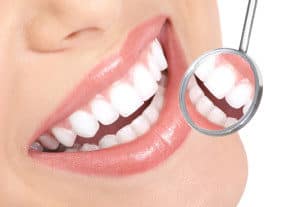What contributes to the success of teeth whitening?

A wide variety of products and processes are available today that enable consumers to have their teeth whitened. These range from basic at-home products – such as whitening toothpaste, adhesive strips and fitted trays with bleaching solution – to in-chair whitening performed by a dentist.
The best choice for any individual can be confusing as the products vary significantly in price and results. Ultimately, successful whitening depends on two main factors: the percentage of whitening agent applied and the method of application.
The first and most important aspect for the consumer to understand is that all forms of tooth whitening involve an irreversible chemical change to the teeth. Therefore it is recommended that a dentist be consulted before the procedure is carried out. Teeth whitening does not cause decay but it can facilitate the process and cause sensitivity. Patients with decayed teeth, infected gums, white spots on their teeth, or multiple tooth-coloured fillings or crowns on the front teeth may not be good candidates for tooth whitening.
What is the difference between pharmacy teeth whitening kits and dentist whitening?
The main difference between pharmacy teeth whitening kits and dentist whitening kits is the amount of bleaching agent that is applied. Hydrogen and carbamide peroxide are the most common active bleaching agents in whitening products. (Carbamide peroxide breaks down into hydrogen peroxide and urea, with hydrogen peroxide being the active whitening ingredient.) The effective concentration of hydrogen peroxide ranges from concentrations as low as 3 per cent to some as high as 25 per cent. Most whitening products available over the counter at pharmacies contain 5.5 per cent hydrogen peroxide.
Pharmacy whitening kits generally have a low percentage of active ingredient. Therefore they often fail to achieve a significant change in colour. Furthermore, they carry the following risks:
- Whitening is done without a dental check-up to determine whether the teeth are healthy and can be safely whitened. Also, not all teeth have suitable enamel structure for whitening. This needs to be assessed by a dental practitioner in order to confirm that whitening can be done safely and effectively.
- Pharmacy whitening kits that include trays are not custom-fitted to your teeth, meaning that they rarely cover the teeth adequately. They risk burning your gums and also increasing the likelihood of patchy colouring across the teeth.
- Whitening gels and toothpastes from pharmacies can be abrasive, wearing the teeth away as they remove staining. Over time this wear can become severe, causing the underlying layer of the tooth, the dentine, to be exposed. This dentine is both yellow and very sensitive. Once it is exposed, no type of whitening technique will be effective.
As advised by the Australian Dental Association, the Australian Competition and Consumer Commission prohibits the supply of home-use teeth whitening products that contain more than 6 per cent hydrogen peroxide or more than 18 per cent carbamide peroxide.
What teeth whitening options to Smile Solutions offer?
Teeth whitening Melbourne dentist Smile Solutions offers patients two kinds of professional teeth whitening: a take home system and an in-chair system.
The take-home option includes custom-fitted trays professionally designed to fit the patient’s teeth perfectly. These trays are considered to be a superior at-home treatment as they are designed to hold bleach gel correctly in place over the teeth while avoiding the gum area. After an initial consultation, one of our dentists will determine which type of whitening gel concentration is best suited to your dental condition: “Day White”, used for an hour a day and containing 9.5 per cent hydrogen peroxide; or “Night White”, used overnight and containing 16 per cent carbamide peroxide.
The in-chair system involves the dentist placing a protective barrier on the gums and a 25 per cent hydrogen peroxide paste on the teeth. A light is used to accelerate to action of the hydrogen peroxide. The paste is removed and reapplied two to three times, depending on the patient’s sensitivity. The procedure can achieve about four to six shades of whitening after only one forty-minute treatment.
Why you should go to the dentist for teeth whitening
Dentist-prescribed whitening will ensure the greatest possible change in colour, as dental practitioners have access to whitening products of a much higher strength than those available in pharmacies. In addition, dentist-prescribed whitening offers greater safety because:
- A consultation and check-up by a dental practitioner provide assurance that your teeth are both healthy and suitable for whitening.
- Dentists can provide expert care and opinion for a tailored whitening approach for each individual patient.
- When having teeth whitened in the dental chair, patients are under the supervision of a qualified dentist. This allows the procedure to be tailored to suit the patient on the day. It also ensures that the procedure is conducted safely.
- At-home whitening kits available from dentists are provided in conjunction with consultation and counselling by the dentist. These kits include custom-fitted trays to ensure a consistent colour change across all of the teeth. It also reduces the risk of burning the gums.
- The concentrations of the products are stronger and therefore yield a more reliable and effective result.
- The dentist can monitor and treat patients who experience sensitivity to the whitening agents. They can modify the procedure for those who are having difficulty getting optimal results.
- Finally, the dentist can help the patient explore other cosmetic dental options such as porcelain or resin veneers, tooth-coloured fillings, gum lifts and tooth shaping used with or without tooth whitening.
With the help of a dentist, the patient’s cosmetic dental goals are more likely to be attained.

